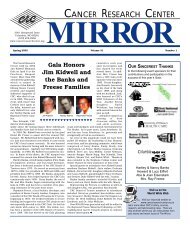2010 Annual Report - Cancer Research Center
2010 Annual Report - Cancer Research Center
2010 Annual Report - Cancer Research Center
You also want an ePaper? Increase the reach of your titles
YUMPU automatically turns print PDFs into web optimized ePapers that Google loves.
Current <strong>Research</strong><br />
site. Nanoparticle work, including testing different nanoparticles and drug formulations, will continue in<br />
2011 and improve the cancer-killing effectiveness of our BCT therapy. (Figure 2) In addition to carrying additional<br />
cancer therapies to the tumor site, nanoparticles can also be used as an important cancer-detection<br />
diagnostic tool as they are easily detected in the body and will be used to confirm that the therapy being<br />
used is properly concentrating at the tumor site inside our animal cancer model and eventually, our clinical<br />
cancer patient.<br />
Work on the BCT therapy to date has attracted the interest of other cancer research facilities, including<br />
Immunophotonics, Inc. The CRC has entered into a collaboration with Immunophotonics to determine if<br />
BCT therapy can be successfully combined with Immunophotonics, Inc. therapeutic technologies that are<br />
already in FDA clinical testing for use in the USA and being successfully used in clinics in Peru. We are<br />
continuing this research partnership in 2011.<br />
We also continue to search for and select bacterial<br />
strains with improved targeting capabilities. In <strong>2010</strong>,<br />
visiting CRC Scholar Dr. Chengzhi Wang developed<br />
an improved protocol for generating strains<br />
that target prostate cancers in our animal prostate<br />
cancer model and is continuing his work to make<br />
a better targeting strain in 2011. Dr. Kazmierczak,<br />
with the assistance of our CRC student interns, is<br />
selecting and screening new bacterial species for<br />
their ability to attach to human prostate cancer<br />
cells in culture. (Figure 3) This work is expected to<br />
continue throughout 2011 and will yield important<br />
information about the nature of bacterial attraction<br />
to cancer cells and tumor masses. As strain generation<br />
progresses we will also be looking for stains with<br />
targeting ability for melanoma , pancreatic, colon<br />
and breast cancers. This work will be done in tissue<br />
culture and will lay the groundwork for approval for<br />
animal model studies of these cancer types in the<br />
future.<br />
Figure 3 Attachment of nanoparticles<br />
on outer perimeter of cancer targeting (2631) cells.<br />
Each year we build on the success of previous years<br />
as we continue the development of a bacterial cancer therapy. It seems like only yesterday the idea of scouring<br />
our unique collection of archival Salmonella for a new weapon against cancer was born. Thanks to our<br />
generous supporters and hard work our Salmonella-based bacterial cancer therapy is making great progress<br />
on the way to becoming an effective treatment in the fight against cancer.<br />
Coley, W. 1929. The cancer symposium at Lake Mohonk. Am. J. Surg. 1:22-23.<br />
Friberg, S. 1993. BCG in the treatment of superficial cancer of the bladder: a review. Med Oncol Tumor<br />
Pharmacother 10:31-6.<br />
A year in review <strong>2010</strong> 13



